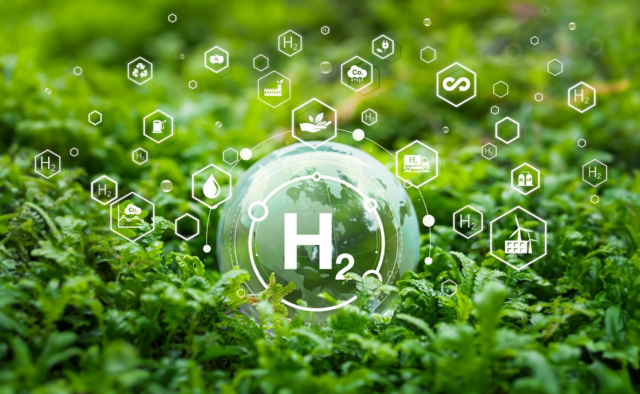Green Hydrogen: The future with challenges
AK Tyagi, Founder, Chairman & Managing Director, Nuberg Engineering Ltd.
EPC World, 9 Dec, 2024
Green Hydrogen: The future with challenges
As the global demand for clean and sustainable energy sources grows, green hydrogen is emerging as an important solution. Positioned at the intersection of energy transition and climate action, green hydrogen has the potential to revolutionize how industries, governments, and economies operate. For a country like India, which has committed to reducing its carbon emissions in alignment with global climate goals, green hydrogen represents a crucial component of the future energy outlook.

Recognizing green hydrogen as a clean energy alternative
Green hydrogen is a flexible way to decarbonize businesses including manufacturing, transportation, and power generation as industries worldwide move toward sustainability. This suggests a future in which clean energy promotes environmental responsibility and economic growth as well. This clean alternative can be used in sectors that are traditionally hard to decarbonize, such as steel production, transportation, and power generation, providing a sustainable alternative to fossil fuels.
Global shift toward green hydrogen: International policies and steps
The global race towards developing and scaling green hydrogen technologies is well underway, with nations worldwide introducing policies and initiatives to harness its potential. In Europe, the European Union’s “Green Deal” highlights hydrogen’s role in achieving carbon neutrality by 2050. The EU has launched a Hydrogen Strategy, that focuses on producing up to 10 million Tonnes of green hydrogen by 2030. Germany has been leading the green hydrogen charge, with its National Hydrogen Strategy set to develop over 5 gigawatts (GW) of green hydrogen production by 2030, supporting the decarbonization of its industrial base. Similarly, countries like Japan and Australia also invest heavily in green hydrogen as part of their energy strategies. Australia has initiated hydrogen export projects like the Asian Renewable Energy Hub, which aims to use wind and solar power to produce green hydrogen at scale for export to Asia.
India’s commitment to green hydrogen
In India, the focus on clean energy has increased as the government recognizes green hydrogen as a transformative force in meeting its climate and energy security goals. As part of its commitment to the Paris Agreement, India aims to reduce its carbon intensity by 45% by 2030 and achieve net - zero carbon emissions by 2070. Central to this goal is the National Hydrogen Mission, launched in August 2021, which aims to make India a global hub for the production and export of green hydrogen. The Ministry of New and Renewable Energy (MNRE) has also outlined ambitious plans to produce 5 Million Tonnes of green hydrogen annually by 2030. The government has also introduced incentives for industries and startups in the hydrogen space, ensuring private - sector participation in developing technologies and infrastructure. The latest government - backed initiative is the “Hydrogen Valley” project. Launched as part of India’s hydrogen strategy, this initiative aims to create hydrogen production hubs across India, focusing on industrial use and export markets. Gujarat, which has seen rapid renewable energy development, is set to become the epicenter of these hydrogen valleys. Furthermore, the government is providing viability gap funding for green hydrogen projects, with a special focus on public - private partnerships. Some leading global firms are also making significant strides in green hydrogen. Their focus on industrial projects is complemented by their efforts in scaling clean energy technologies, including green hydrogen. Several flagship projects are also developed in collaboration with National Fertilizers Limited (NFL) to build India’s first green hydrogen plant. These projects will not only help reduce the carbon footprint of fertilizer production but also lay the groundwork for future green hydrogen initiatives across India.
Challenges in green hydrogen adoption
Despite its immense promise, the large - scale adoption of green hydrogen faces several challenges.
- Cost: The most significant barrier is the high production cost of green hydrogen, is that it is more expensive than hydrogen derived from fossil fuels. Improving renewable energy infrastructure and reducing the cost of electrolyzers are important in lowering costs.
- Infrastructure: Lack of existing hydrogen infrastructure, such as storage, transport, and refueling stations, is another major hurdle. Building a nationwide hydrogen grid requires substantial investment and planning in infrastructure.
Energy efficiency: Producing hydrogen through electrolysis is energy - intensive
- Technological Gaps: The most significant barrier is the high production cost of green hydrogen, is that it is more expensive than hydrogen derived from fossil fuels. Improving renewable energy infrastructure and reducing the cost of electrolyzers are important in lowering costs.
- Looking ahead: Opportunities for engineers: The transition to green hydrogen offers a number of opportunities, especially for engineers working in the fields of energy, infrastructure, and technology. Engineering advancements are crucial in making green hydrogen a viable energy source on a global scale, further supporting the Sustainable Development Goals (SDGs), particularly SDG 7 and 13 which focuses on ensuring access to affordable, reliable, sustainable, and modern energy for all.
Green hydrogen is undeniably the fuel of the future, offering a path toward de - carbonization and energy security. As the world looks for sustainable alternatives to fossil fuels, India, through its National Hydrogen Mission and public - private collaborations, is well - positioned to be a global leader in green hydrogen production. However, addressing the challenges of cost, infrastructure, and technology is critical to making green hydrogen an economically viable and sustainable energy source. With government initiatives, international cooperation, and engineering advancements, green hydrogen has the potential to reshape the global energy landscape and drive the world toward a cleaner, greener future.
© This article was first published in EPC World, 9 Dec, 2024.
Media Gallery
EPC World - Green Hydrogen: The future with challenges

